FCC raises the broadcast flag in war over fair use
The FCC unanimously voted last week to permit broadcast networks and motion picture studios to insert a special digital marker — called a broadcast flag — into the data stream of DTV signals and restrict re-use of the signal by viewers. The restrictions apply to digital broadcasts of news and public affairs shows as well as entertainment programming.
The broadcast flag, which will be read by new consumer electronics equipment, is meant to prevent viewers from copying broadcasts of television shows and movies and widely distributing them on the Internet. Critics strongly contend that it will not only stop piracy, but will make digital television more costly and less desirable for viewers.
The controversial decision is expected to open a heated new debate over fair-use of television program content in the digital era. It was a political victory for major content owners—including the television networks and Hollywood studios—which had lobbied hard at the FCC for its passage.
The program owners contend that they need regulatory and technological protection to avoid the kind of copying that has haunted the commercial music industry. FCC Chairman Michael Powell said the new rule is essential to accelerating the transition to digital television, and struck a “careful balance between content protection and technology innovation in order to promote consumer interests.”
The movie industry spun the victory as a win for viewers. “The FCC scored a big victory for consumers and the preservation of high-value over-the-air free broadcasting with its decision,” said Jack Valenti, the president and chief executive of the Motion Picture Association of America (MPAA). “This puts digital TV on the same level playing field as cable and satellite delivery. All the way around, the consumer wins and free TV stays alive.”
If the new ruling survives an expected court challenge, it would require electronics manufacturers to install the new flag technology by July 2005 on any device that receives a digital broadcast signal. That includes new DTV receivers, VCRs and DVD players. Though the flag decision affects only terrestrial broadcasting, cable and satellite systems that retransmit such signals will also be affected in unknown ways.
Under the mandate, a TV program could only be copied by a digital recording device equipped with technology that recognizes the broadcast flag. A computer could not copy the file to its hard drive, which is necessary for it to be sent onto the Internet. The rule targets digital video recorders with the ability to copy programs to DVDs rather than to videocassettes.
The professional video industry's #1 source for news, trends and product and tech information. Sign up below.
Viewers who want to record shows using conventional analog VCRs will not be affected by the rule, and will be able to watch flagged programming on any television display.
The FCC refused to specify technologies for use in implementing the DTV restriction. Instead, they charted a “roadmap for companies seeking to bring new technology to the market. Earlier, the flag proposal would have required product makers to use specific encryption technology from an approved list of companies.
However, Commissioner Kathleen Abernathy said the FCC “set up on an interim basis a transparent, open and objective approval process that will promote the development of competition in the marketplace and foster innovation.” She said the FCC would provide a list of approved technologies sometime in early 2004.
For more information visit www.fcc.gov.
